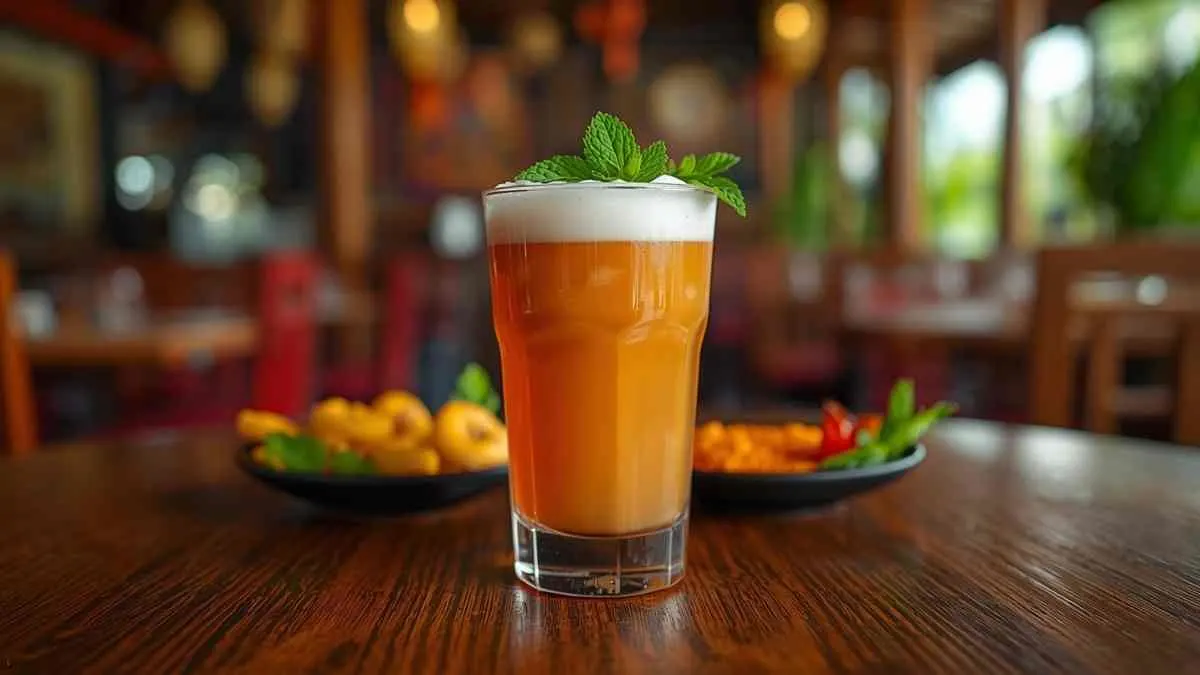Thai tea, or cha yen (ชาเย็น), is a beloved beverage that offers a delightful blend of bold flavors and creamy textures. Originating from Thailand, this tea has gained international popularity for its unique taste and vibrant orange hue.
In this comprehensive guide, we’ll delve into the origins of Thai tea, its cultural significance, provide a step-by-step recipe, and answer common questions to enhance your tea experience.
What Is Thai Tea?
Thai tea is a traditional beverage originating from Thailand, known for its rich flavor, vibrant orange color, and aromatic spices. Made from strongly brewed black tea, Thai tea is typically flavored with a combination of spices such as star anise, cinnamon, and sometimes vanilla, which contribute to its distinct taste. The tea is sweetened with sugar and then mixed with evaporated or condensed milk, creating a creamy and indulgent drink.
Traditionally served over ice, Thai tea is a popular street food beverage in Thailand, especially enjoyed during hot weather. The unique flavor profile of Thai tea comes from the combination of bold black tea and the sweet, creamy milk, often with a hint of spice. In some variations, orange food coloring is added to achieve its signature bright hue, though this step is optional.
While it’s often served as a cold, iced tea, it can also be enjoyed hot. Thai tea has gained international popularity and is commonly found in Thai restaurants around the world. Whether iced or hot, this flavorful tea offers a perfect balance of sweetness, creaminess, and spiciness that delights the palate.
Step-by-Step Thai Iced Tea Recipe:

Ingredients:
-
2 cups water
-
2 tablespoons Thai tea leaves (or Thai tea mix)
-
2 tablespoons sugar (adjust to taste)
-
2 tablespoons sweetened condensed milk
-
2 tablespoons evaporated milk
-
Ice cubes
Instructions:
-
Boil the Water: In a saucepan, bring 2 cups of water to a boil.
-
Brew the Tea: Add the Thai tea leaves to the boiling water. Reduce the heat and let the tea simmer for about 5 minutes, allowing the flavors to steep.
-
Sweeten the Tea: Add 2 tablespoons of sugar to the tea and stir until completely dissolved.
-
Strain the Tea: Remove the saucepan from heat and strain the tea into a pitcher to remove the tea leaves.
-
Cool the Tea: Allow the tea to cool to room temperature, then refrigerate it until chilled.
-
Prepare the Glasses: Fill glasses with ice cubes.
-
Mix the Tea: Pour the chilled tea into the prepared glasses, filling each about two-thirds full.
-
Add the Creaminess: Slowly pour 2 tablespoons of sweetened condensed milk into each glass. Then, add 2 tablespoons of evaporated milk on top.
-
Stir and Serve: Stir the tea to combine the layers and enjoy your homemade Thai iced tea.
Note: For a more authentic experience, you can use a Thai tea sock filter to brew the tea, which is commonly used in Thailand to prepare the beverage.
Health Benefits of Thai Tea:
While Thai tea is often enjoyed for its refreshing taste, it also offers several health benefits:
-
Rich in Antioxidants: The black tea base is rich in antioxidants, which can help combat oxidative stress and reduce the risk of chronic diseases.
-
Digestive Aid: The spices commonly used in Thai tea, such as star anise and cardamom, are known to aid digestion and alleviate bloating.
-
Boosts Metabolism: The caffeine content in Thai tea can provide a mild energy boost and may help increase metabolism.
Note: The addition of sweetened condensed milk and sugar increases the calorie content of Thai iced tea, so it’s best enjoyed in moderation.
Recommended: 6 Types Of Tea
Variations Tips:
-
Flavor Variations: Add spices like star anise, cinnamon, or cardamom during brewing for an extra layer of flavor.
-
Milk Substitutes: For a dairy-free version, swap sweetened condensed milk and evaporated milk with coconut milk or almond milk.
-
Sweetener Alternatives: Use honey, agave syrup, or stevia instead of sugar for a more natural sweetener.
-
Iced vs. Hot: While Thai tea is typically served iced, you can enjoy it hot by simply omitting the ice and serving it in a warm mug.
-
Vegan Thai Tea: Use coconut milk and a plant-based sweetener like maple syrup for a fully vegan version of Thai iced tea.
-
Extra Creaminess: For a richer taste, add extra evaporated milk or a dollop of whipped cream on top before serving.
-
Herbal Infusion: Mix in a few dried hibiscus petals during the brewing process for a floral twist and a beautiful reddish color.
-
Boba Addition: For a true Thai bubble tea experience, add tapioca pearls (boba) at the bottom of your glass for added texture.
-
Matcha Twist: For a green tea variation, mix in a teaspoon of matcha powder with your Thai tea to create a vibrant green Thai Matcha Tea.
-
Fruit Infusion: Add a slice of lime or orange zest to the tea for a citrusy kick that balances out the sweetness.
Common Questions:
1. Can I make Thai iced tea without sweetened condensed milk?
Yes, you can substitute sweetened condensed milk with a combination of regular milk and sugar to achieve a similar sweetness and creaminess.
2. Is Thai iced tea suitable for vegetarians?
Traditional Thai iced tea is vegetarian-friendly. However, if you’re vegan, ensure that the sweetened condensed milk and evaporated milk are plant-based alternatives.
3. Can I make Thai iced tea without food coloring?
Absolutely. The vibrant orange color is often achieved with food coloring, but it’s not essential for the flavor. You can enjoy a natural-colored tea by omitting the coloring.
4. How can I store leftover Thai iced tea?
Store any leftover tea in an airtight container in the refrigerator for up to 2 days. When ready to serve, pour over fresh ice and add milk as desired.
5. Can I use green tea instead of black tea for Thai iced tea?
While traditional Thai iced tea uses black tea, you can experiment with green tea for a lighter flavor. Keep in mind that this will alter the traditional taste.

